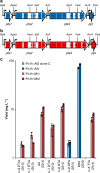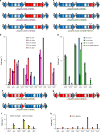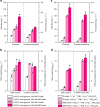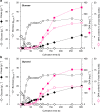Polyunsaturated fatty acid production by Yarrowia lipolytica employing designed myxobacterial PUFA synthases
- PMID: 31492836
- PMCID: PMC6731297
- DOI: 10.1038/s41467-019-12025-8
Polyunsaturated fatty acid production by Yarrowia lipolytica employing designed myxobacterial PUFA synthases
Abstract
Long-chain polyunsaturated fatty acids (LC-PUFAs), particularly the omega-3 LC-PUFAs eicosapentaenoic acid (EPA), docosapentaenoic acid (DPA), and docosahexaenoic acid (DHA), have been associated with beneficial health effects. Consequently, sustainable sources have to be developed to meet the increasing demand for these PUFAs. Here, we demonstrate the design and construction of artificial PUFA biosynthetic gene clusters (BGCs) encoding polyketide synthase-like PUFA synthases from myxobacteria adapted for the oleaginous yeast Yarrowia lipolytica. Genomic integration and heterologous expression of unmodified or hybrid PUFA BGCs yielded different yeast strains with specific LC-PUFA production profiles at promising yield and thus valuable for the biotechnological production of distinct PUFAs. Nutrient screening revealed a strong enhancement of PUFA production, when cells were phosphate limited. This represents, to the best of our knowledge, highest concentration of DHA (16.8 %) in total fatty acids among all published PUFA-producing Y. lipolytica strains.
Conflict of interest statement
The authors declare no competing interests.
Figures





Similar articles
-
Metabolic engineering of Pseudomonas putida for production of docosahexaenoic acid based on a myxobacterial PUFA synthase.Metab Eng. 2016 Jan;33:98-108. doi: 10.1016/j.ymben.2015.11.001. Epub 2015 Nov 24. Metab Eng. 2016. PMID: 26617065
-
Refactoring the architecture of a polyketide gene cluster enhances docosahexaenoic acid production in Yarrowia lipolytica through improved expression and genetic stability.Microb Cell Fact. 2023 Sep 29;22(1):199. doi: 10.1186/s12934-023-02209-9. Microb Cell Fact. 2023. PMID: 37773137 Free PMC article.
-
Multi-omics view of recombinant Yarrowia lipolytica: Enhanced ketogenic amino acid catabolism increases polyketide-synthase-driven docosahexaenoic production to high selectivity at the gram scale.Metab Eng. 2023 Nov;80:45-65. doi: 10.1016/j.ymben.2023.09.003. Epub 2023 Sep 7. Metab Eng. 2023. PMID: 37683719
-
Recent advances in biotechnological production of polyunsaturated fatty acids by Yarrowia lipolytica.Crit Rev Food Sci Nutr. 2022;62(32):8920-8934. doi: 10.1080/10408398.2021.1937041. Epub 2021 Jun 14. Crit Rev Food Sci Nutr. 2022. PMID: 34120537 Review.
-
Sustainable source of omega-3 eicosapentaenoic acid from metabolically engineered Yarrowia lipolytica: from fundamental research to commercial production.Appl Microbiol Biotechnol. 2015 Feb;99(4):1599-610. doi: 10.1007/s00253-014-6318-y. Epub 2015 Jan 8. Appl Microbiol Biotechnol. 2015. PMID: 25567511 Free PMC article. Review.
Cited by
-
Lipid Production from Native Oleaginous Yeasts Isolated from Southern Chilean Soil Cultivated in Industrial Vinasse Residues.Microorganisms. 2023 Oct 9;11(10):2516. doi: 10.3390/microorganisms11102516. Microorganisms. 2023. PMID: 37894174 Free PMC article.
-
Building a cell-factory in Crithidia fasciculata: a bio-sustainable system to produce high-value polyunsaturated fatty acids.Microb Cell Fact. 2025 Jun 23;24(1):142. doi: 10.1186/s12934-025-02760-7. Microb Cell Fact. 2025. PMID: 40551153 Free PMC article.
-
Deciphering and engineering the polyunsaturated fatty acid synthase pathway from eukaryotic microorganisms.Front Bioeng Biotechnol. 2022 Nov 14;10:1052785. doi: 10.3389/fbioe.2022.1052785. eCollection 2022. Front Bioeng Biotechnol. 2022. PMID: 36452206 Free PMC article. Review.
-
Accumulation of docosapentaenoic acid (n-3 DPA) in a novel isolate of the marine ichthyosporean Sphaeroforma arctica.Biotechnol Lett. 2024 Jun;46(3):373-383. doi: 10.1007/s10529-024-03472-5. Epub 2024 Mar 16. Biotechnol Lett. 2024. PMID: 38493279
-
Yarrowia lipolytica as an Oleaginous Platform for the Production of Value-Added Fatty Acid-Based Bioproducts.Front Microbiol. 2021 Jan 5;11:608662. doi: 10.3389/fmicb.2020.608662. eCollection 2020. Front Microbiol. 2021. PMID: 33469452 Free PMC article. Review.
References
-
- Nicaud JM, et al. Protein expression and secretion in the yeast Yarrowia lipolytica. FEMS Yeast Res. 2002;2:371–379. - PubMed
-
- Madzak C, Treton B, Blanchin-Roland S. Strong hybrid promoters and integrative expression/secretion vectors for quasi-constitutive expression of heterologous proteins in the yeast Yarrowia lipolytica. J. Mol. Microbiol. Biotechnol. 2000;2:207–216. - PubMed
-
- Madzak C. New tools for heterologous protein production in the yeast Yarrowia lipolytica. Recent Res. Dev. Microbiol. 2003;7:453–479.
Publication types
MeSH terms
Substances
LinkOut - more resources
Full Text Sources
Other Literature Sources
Research Materials

